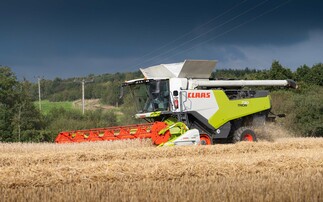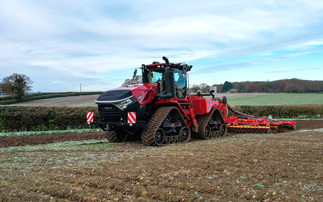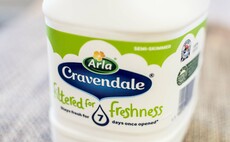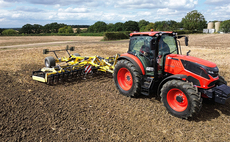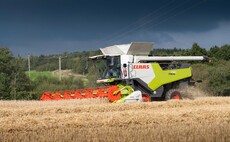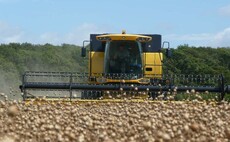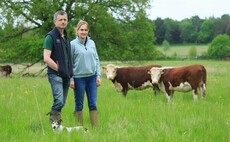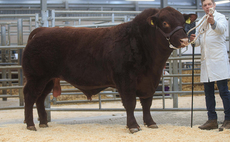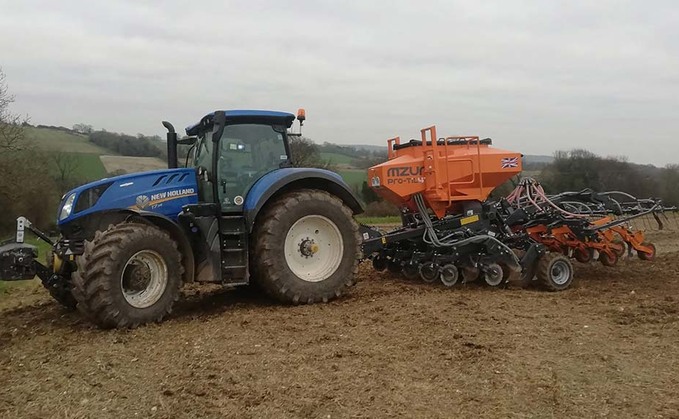
In search of lower establishment costs and improved soil heath, one West Sussex grower has invested in an Mzuri strip-till seeder complete with precision seeding capability. Geoff Ashcroft reports.
Moving soil has become an expensive pastime according to James Bray of Hundred Acres Farm, Compton, near Chichester, West Sussex.
"The cost of production is increasing year-on-year," says James Bray of A.B. Bray and Son.
"To reduce fuel, operate with fewer passes and remain profitable with wheat prices at £120 per tonne, we have had to look at all the options for establishment."
The 520-hectare family farm he runs with his father, Nick, has been managed on a mixed establishment system for a number of years with combinable crops. The rotation includes winter wheat, winter and spring barley, and winter oats. A 600-head beef enterprise adds grass and maize silage to the mix, helping to manage weed incidence.
Aiming to reduced cultivations, the business made the most of a six-metre Weaving Tine Drill, alongside a Weaving Sub Disc cultivator to provide a two-pass system. A 4m power harrow drill combination and plough also provide a get out of jail free card, for extreme conditions.
"The next logical step was to look at one-pass establishment," says Mr Bray.
"I liked the idea of strip-tillage rather than a disc drill, as we could avoid hair-pinning from a disc. I figured if we could create a narrow band of tilth into which seed could be placed, then we would not need to make full-width cultivations for cereal crops."
Trash
He adds surface trash is not considered excessive. The farm bales most of its cereal straw for the beef unit, but chops oat straw. Manure from cattle sheds is recycled back onto land, which adds organic matter and provides an additional source of nitrogen too.
"By putting cereal seed into two rows in a strip of soil we could leave a lot of the soil untouched to promote natural soil restructuring, and allow the ground to improve its ability to carry in-field traffic," he says.
"It has also resulted in fewer weeds, from leaving a lot of soil untouched."
It was a move which saw the farm try a Mzuri Pro-Till 3T drill last year, which showed an increased ability to retain moisture as summer temperatures rose.
"Those crops planted using the Pro-Till suffered less drought-related stress compared to those we had drilled with the Tine Drill," he says.
"I also liked the idea of it being British-made. With the help of a Leader grant, we could take a cost-effective step into one-pass, low disturbance drilling for our cereals."
While the demonstration model was a 3m unit, the farm eventually opted for a 4m Pro-Till 4T model to make the most of frontline horsepower - a hired-in New Holland T7.315.
"We were looking to get all our spring crops planted with the Pro-Till, but its late arrival meant we had the opportunity to compare establishment systems," he says.
Costs
"And while we have seen no additional yield gain or penalty, we have removed about £100/ha from our establishment costs by switching to the one-pass process."
Buying the drill with the help of a grant also steered the farm towards extra specification. And for the Brays' business, this meant adding the optional Xzact seed singulation system, to turn the Pro Till machine into one offering precision seeding to suit the farm's maize crop.
"We no longer grow oilseed rape, but we plant 60ha of maize every year for our beef cattle," he says.
"We have used a contractor for all our maize planting and harvesting for years and we have no complaints at all from their service," he says.
"But having two drills in one has given us the opportunity to make use of our own kit and trim some of the maize establishment costs. It is also another opportunity to justify investment in the drill and spread our machinery costs."
Xzact is an optional extra which can be fitted to the Pro-Till seeder. It uses a precision seed singulation unit and coulter fitted to the rear-most row of legs. In the case of Mr Bray's 4m unit, it is installed onto six rows and sees the other five lifted clear of the ground when ‘precision seeding' mode is selected.
This creates a 65cm row spacing and each seeding unit is kept topped-up with seed from the drill's main seed tank.
"In cereals, we sow two rows in a 12.5cm strip with a 20cm gap of uncultivated ground in between. We switch to precision drilling mode in maize and plant six rows at 65cm. Down the row spacing is good too and it seems to have done a great job with seed placement."
Mr Bray says converting the drill takes about half a day, to add the units and connect everything up. And regardless of the crop being drilled, the machine's hydraulic folding wings require a certain knack to get them unfolded and pinned.
"We need to use a piece of wood under each outer transport wheel when unfolding," he says. "You just cannot fold down and expect the wheels to be forced into position. And it is the same when folding up."
When it comes to preparing the maize seedbed, the farm has carried out its own trials with cultivations.
"We made a deep pass with the Sub Disc, then chose to power harrow one half of a field, and left the other half, ahead of the drill," he says. "And when it came to harvesting, there was no difference. But one side of the field cost considerably more to prepare than the other."
When it comes to tractor power, the T7.315 is currently just enough for the drill.
"Steep banks and front loosening legs operating at 18-20cm deep do demand almost all of what the T7 can provide. We have been drilling at speeds of up to 12kph and the drill's points have now covered about 300ha and are almost due for replacement.
Infiltration
"We have seen an improvement with water infiltration and in this particularly wet autumn we have managed to get most of our crops in where others have yet to make progress.
"As our soils become more friable and easier to work, we should see a reduction in fuel use and need less power.
"Fields have travelled much better than we thought they would, but doing so has meant removing the front discs to prevent them collecting and dragging trash in less than ideal conditions. Like most kit, the drill works so much better in dry conditions."
He says that post-harvest, weeds and volunteers are flushed out and hit with a shallow disc harrow, with any subsequent growth managed with the sprayer ahead of drilling. Wheat after maize is not yet a one-pass process as the farm is still working out the best way to process stalks to manage any pest and disease incidence.
"We are still in the trial stages, but the Pro-Till has made farming much more interesting again. We have also tried under-sown grass in barley, which ended up being combined.
"This drill has given us options and the confidence to look at establishment from a different perspective. It has also put the focus on soil health rather than simply bashing soil to a pulp to make a fine seedbed."
When it comes to frontline horsepower, the business has traditionally opted for 300hp supplied by a local hirer.
With an intensive approach, the fixed costs of hiring have been more attractive than outright tractor ownership.
"Depreciation has been difficult to swallow for a farm of this size, so a hired-in tractor has done the lion's share of work. But since we changed our establishment system, that tractor is now doing much less and, as a result, its costs are creeping up against the hours and hectares now covered. And it has now become beneficial to own rather than hire."
It means a Fendt 930 will soon arrive on-farm, complete with a five-year, 5,000-hour warranty, giving reassurance for repair and maintenance costs over the first five years of ownership.
Value
"Historically, we believe the Fendts also seem to have a better residual value than many other brands. With on the move tyre inflation and the ability to add and remove a huge amount of ballast, we will have a far more versatile 300hp tractor."
Mr Bray reports the farm has made some useful progress in a relatively short time frame.
"We have gone through a lot of changes to streamline our cultivations and the way we look at our machinery purchases, but without detriment to soil structure or crop establishment. And we have found ourselves with some spare capacity too, which could also open up opportunities for the business to expand," he says.
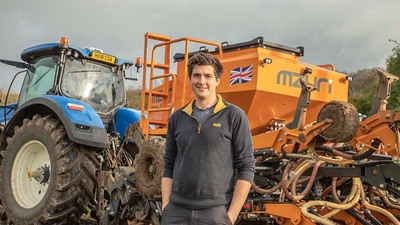
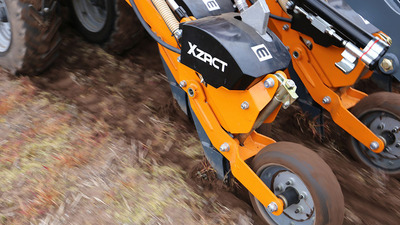
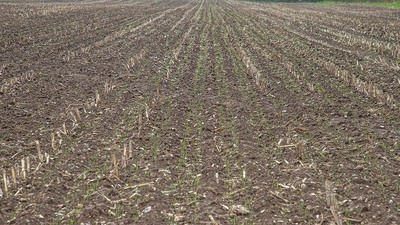
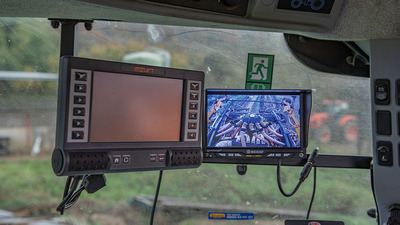
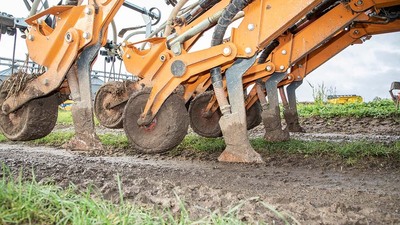
Mzuri data
- Model: Pro-Til 4T Xzact
- Working width: Four metres
- Transport width: 2.98m
- Hoper capacity: 3,400 litres
- Row spacing: 32.5cm or 65cm
- Coulters: 11 or 6
- Price: from £106,143
- Options: Front discs £6,450; seed monitoring £2,420














